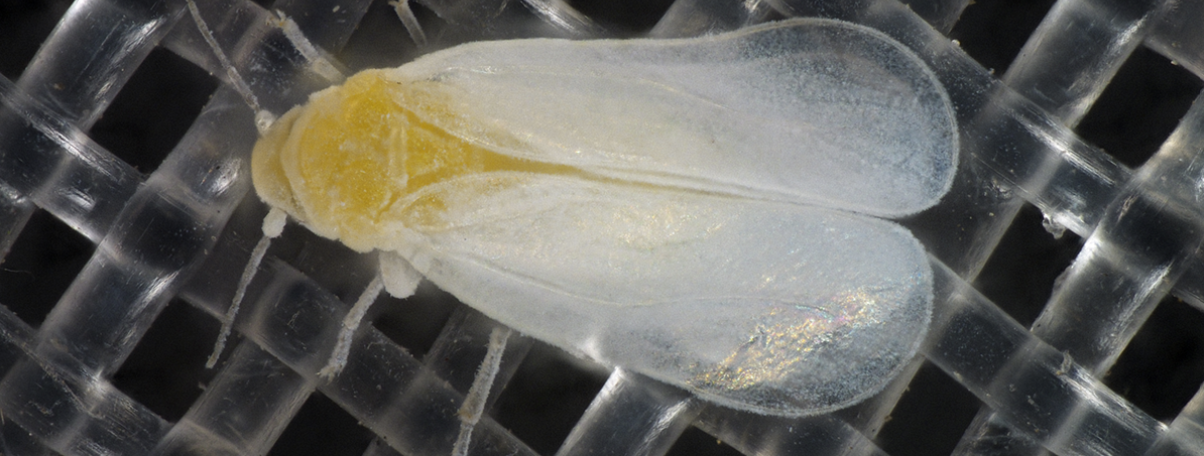Controlling whitefly in greenhouses with agricultural mesh
Whiteflies are among the most persistent and costly pests in greenhouse production, particularly in Mexico’s warm and semi-arid regions. Though barely visible to the naked eye, these tiny insects can weaken plants, transmit destructive viruses and trigger secondary problems such as sooty mould. Understanding how whiteflies behave — and how their biology interacts with climate — is the foundation for effective, non-chemical control.
In this article- Why whitefly control matters
- Types of whitefly in greenhouse production
- Understanding the whitefly cycle
- Temperature and seasonal dynamics
- Behavior and spread
- Physical exclusion with agricultural mesh
- Integrating physical and biological control
- Climate change and the future of whitefly management
Why whitefly control matters
In Mexico, whitefly infestations are common in tomato, pepper, and cucumber crops, where they can cause yield losses of up to 50 % if unmanaged. The main culprit is the sweet potato whitefly, Bemisia tabaci, though the greenhouse whitefly, Trialeurodes vaporariorum, is also present in cooler highland areas. Both species feed on plant sap using piercing–sucking mouthparts and excrete sticky honeydew, which promotes sooty mould growth and interferes with photosynthesis.
More damaging still is their role as virus vectors. In tomatoes, Bemisia tabaci transmits Tomato yellow leaf curl virus (TYLCV) and Tomato chlorosis virus (ToCV) — diseases that deform foliage, stunt plants, and drastically reduce fruit quality. Because a single infected female can spread virus after feeding for only a few minutes, exclusion rather than treatment is the most effective form of protection. Svensson has assembled a series of articles, guides and resources to assist growers who are seeking to exclude whitefly from their crops.
Types of whitefly in greenhouse production
Whitefly is a collective term for several visually similar species, each with slightly different behavior and environmental preferences.
|
Species |
Common name |
Main greenhouse hosts |
Preferred conditions |
Virus transmission |
|
Bemisia tabaci (MEAM1, MED* biotypes) |
Sweet potato whitefly |
Tomato, pepper, cucumber, cotton |
Warm, dry, bright climates |
TYLCV, ToCV, ToLCNDV |
|
Trialeurodes vaporariorum |
Greenhouse whitefly |
Tomato, cucumber, ornamentals |
Cooler, humid highland zones |
ToCV (minor) |
|
Dialeurodes citri |
Citrus whitefly (occasional invader) |
Ornamentals, citrus near greenhouses |
Warm, coastal areas |
Non-vector of TYLCV |
Of these, B. tabaci is by far the most economically significant and the most difficult to control in Mexico’s greenhouse regions.
* MEAM1 and MED refer to two of the most widespread subspecies highly invasive Middle East-Asia Minor 1, and Mediterranean, which has more resistance to pesticides.
Understanding the whitefly life cycle
Whiteflies develop through six main stages: egg, four immature nymphal stages (collectively called “scales”), and the winged adult. Eggs are laid on the underside of young leaves and hatch in about a week under optimal temperatures (25–30 °C). The juveniles remain attached to the leaf surface, drawing nutrients until they mature.
Adults live for two to four weeks, depending on temperature, and each female can lay over 100 eggs during that time. The female averages 0.67-0.8 mm in length* and the males 0.51-0.68mm. A hole size of 0.4mm is recommended to exclude them.
Males live shorter lives, and play little direct role in virus transmission. Females feed more frequently and for longer periods, making them the primary vectors of viral disease. The sex ratio also shifts with temperature: higher temperatures favour more female offspring, accelerating population growth.
*Tay W.T., Evans G.A., Boykin L.M., De Barro P.J. (2012) Will the Real Bemisia tabaci Please Stand Up? PLOS ONE, 7(11): e50550.https://doi.org/10.1371/journal.pone.0050550
Temperature and seasonal dynamics
Whiteflies are temperature-driven insects. Reproduction and development speed up dramatically between 25 °C and 35 °C, allowing populations to explode during hot summers and mild winters. Under greenhouse conditions, where temperatures remain stable, generations can overlap continuously — one reason infestations are so persistent once established.
When winters are warm, more adults survive outdoors, ready to re-invade greenhouses earlier in spring. Conversely, extreme heat above 38 °C can reduce fertility and shorten adult lifespan, but in most Mexican production areas, internal greenhouse temperatures rarely stay that high for long. The net result: longer growing seasons and warmer nights now give whiteflies more opportunities to multiply.
As climate patterns shift toward hotter, drier summers, whitefly pressure is likely to increase further, making preventive measures — such as physical exclusion — even more critical.
Behavior and spread
 Whiteflies prefer bright, warm microclimates, often concentrating on the sunny sides of greenhouses and upper canopy leaves. Adults are weak fliers but are easily carried by air currents or thermal lift. Populations frequently start on weeds or ornamentals around greenhouse perimeters, spreading inward through vents or doorways.
Whiteflies prefer bright, warm microclimates, often concentrating on the sunny sides of greenhouses and upper canopy leaves. Adults are weak fliers but are easily carried by air currents or thermal lift. Populations frequently start on weeds or ornamentals around greenhouse perimeters, spreading inward through vents or doorways.
Because their feeding behavior involves brief probing of multiple leaves, even a small number of adults can disseminate virus quickly across a crop. Chemical control can knock down adults temporarily, but resistance to common insecticides is widespread in Mexico, and nymphs protected on the undersides of leaves are largely unaffected.
Physical exclusion with agricultural insect mesh
Agricultural insect meshes or nets are now one of the most reliable tools for preventing whitefly invasion. By forming a physical barrier at vents, sidewalls, and doors, they intercept adults before they can enter or exit.
Choosing the right mesh
- 40–50 mesh nets (≈ 0.4 mm openings are necessary) effectively block Bemisia tabaci and T. vaporariorum while still allowing adequate airflow for most vegetable crops.
- In regions with high thrips pressure, finer 60–80 mesh nets may be necessary, though these increase resistance to ventilation.
- When selecting mesh, consider local climate and vent area: finer meshes may require larger vents or forced airflow to maintain temperature and humidity within acceptable limits.
Installation and maintenance
- Fit mesh securely over side vents and roof openings, ensuring no gaps or loose edges.
- Use double-door entries or airlocks where practical to reduce pest ingress during work hours.
- Inspect regularly for tears or clogging with dust, which can reduce porosity and air movement.
- Combine with weed management and perimeter cleaning to eliminate external breeding sites.
Integrating biological and cultural control
Physical exclusion works best as part of an integrated pest management (IPM) program. In Mexico, commercial growers increasingly release beneficial insects such as:
- Encarsia formosa and Eretmocerus eremicus (parasitic wasps targeting whitefly nymphs),
- Macrolophus pygmaeus and Delphastus catalinae (predatory bugs and beetles feeding on eggs and larvae).
Good crop hygiene — removing plant debris, controlling volunteer plants, and cleaning screens between cycles — limits re-infestation. Reflective mulches and selective UV-blocking greenhouse covers can also reduce whitefly orientation and landing rates.
Climate change and the future of whitefly management
Rising temperatures and longer growing seasons are creating conditions increasingly favorable to whiteflies. With more female-biased populations, faster life cycles, and shorter generation times, infestations can build exponentially. Pesticide resistance compounds the challenge, leaving physical and biological control as the most sustainable long-term strategies.
The move toward net-protected cultivation in Mexico reflects this reality. Well-ventilated structures equipped with correctly specified insect mesh offer growers a practical means to reduce virus transmission risk while maintaining crop quality and yield. In regions where summers are becoming hotter and drier, investing in proper netting and ventilation design is not just a protective measure — it’s a prerequisite for sustainable production.
In summary
Whitefly control is about understanding biology, not just blocking insects. By recognizing how female activity, temperature, and seasonal dynamics interact, growers can predict periods of highest risk and tailor mesh choice accordingly. Agricultural insect nets — when integrated with biological control and sound hygiene — give greenhouse producers in Mexico a realistic and environmentally responsible way to stay ahead of one of their most adaptable enemies.





